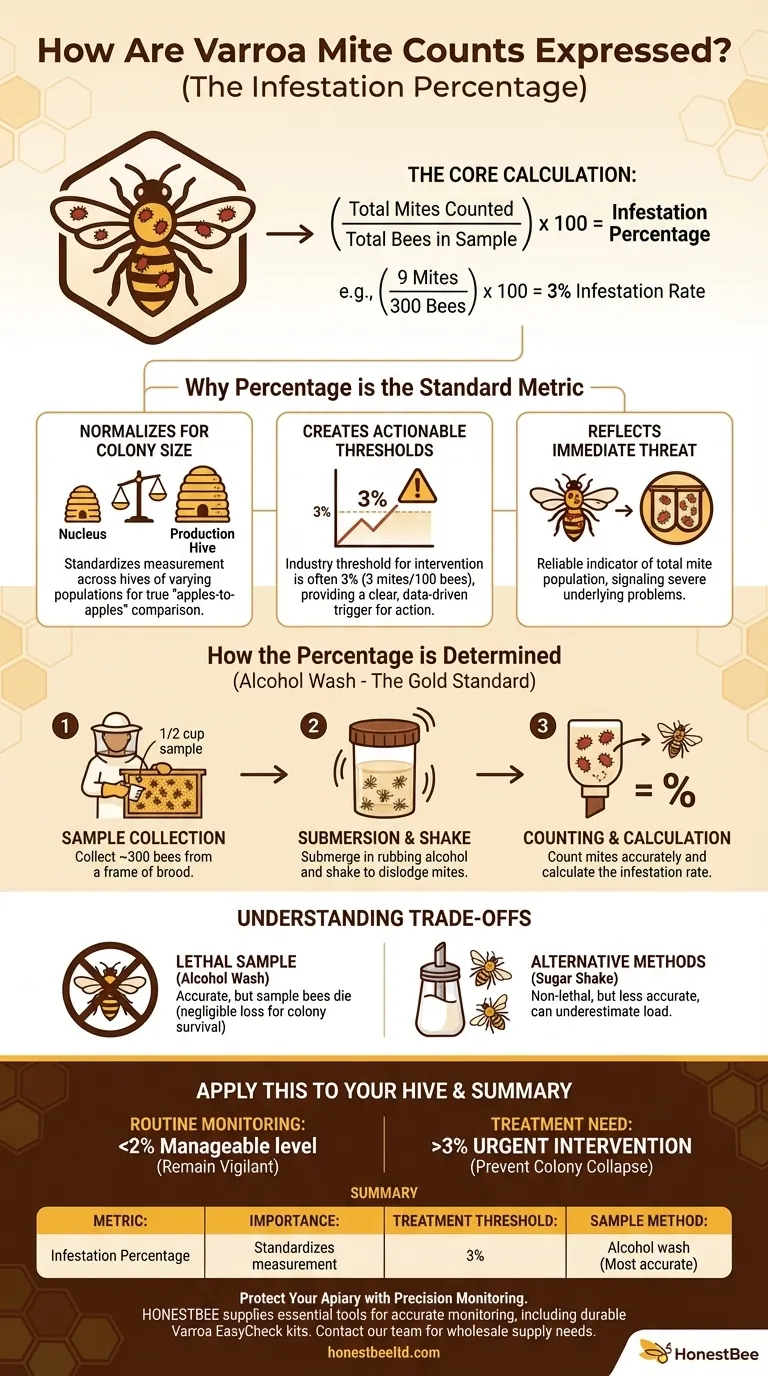At its core, a Varroa mite count is expressed as a percentage. This number represents the mite infestation rate, calculated as the number of mites found per 100 adult bees in a given sample. It is the universal standard for assessing the health of a honey bee colony in relation to this critical parasite.
The entire system of Varroa mite management hinges on a single, standardized metric: the infestation percentage. This allows beekeepers to compare hive health over time, against other colonies, and to industry-wide treatment thresholds, turning a simple count into an actionable piece of data.

Why Percentage is the Standard Metric
Expressing the mite count as a percentage, rather than a raw number, provides essential context. A raw count of 50 mites means very different things in a small nucleus colony versus a booming production hive.
It Normalizes for Colony Size
A percentage standardizes the measurement across hives of varying populations. This allows for a true "apples-to-apples" comparison of infestation levels, whether you are managing two hives or two hundred.
It Creates Actionable Thresholds
The beekeeping industry has established treatment thresholds based on this percentage. For example, many experts recommend intervention when the mite load reaches or exceeds 3% (3 mites per 100 bees), especially in the late summer and fall. This gives beekeepers a clear, data-driven trigger for action.
It Reflects the Immediate Threat
The count of mites on adult bees (the "phoretic" stage) is a reliable indicator of the total mite population within the hive, including those reproducing under capped brood. A higher percentage on adult bees signals a more severe underlying problem that threatens the colony's survival.
How the Percentage is Determined
The percentage is not an estimate; it's a calculation based on a physical sample of bees taken from the hive. The most common and reliable method is the alcohol wash.
The Core Calculation
The formula is simple and direct: (Total Mites Counted / Total Bees in Sample) x 100 = Infestation Percentage
For example, if you find 9 mites in a sample of 300 bees, your calculation would be (9 / 300) * 100, which equals a 3% infestation rate.
The Alcohol Wash Method
This is considered the gold standard for accuracy by researchers and professional beekeepers. A sample of bees (typically a 1/2 cup measure, which is roughly 300 bees) is collected from a frame of brood and submerged in rubbing alcohol. The container, such as a Varroa EasyCheck, is shaken, which dislodges the mites from the bees' bodies, allowing for an easy and accurate count.
Understanding the Trade-offs
While the alcohol wash is highly accurate, it's important to understand its primary trade-off.
Accuracy Comes at a Cost
The main drawback of the alcohol wash is that it is a lethal sample—the bees used in the test will die. However, the loss of ~300 bees from a healthy colony of 30,000-50,000 is negligible and is considered a worthwhile sacrifice for obtaining precise data crucial to the entire colony's survival.
Alternative Methods Exist
Other methods, like the powdered sugar shake, are non-lethal but are generally considered less accurate and more variable. They can underestimate the true mite load, potentially leading a beekeeper to delay necessary treatments.
Sample Location Matters
For the most representative percentage, samples should be taken from a frame containing brood. Mites are often concentrated in this area of the hive, as they are preparing to enter brood cells to reproduce. Sampling from a frame of only honey or pollen can give you a falsely low reading.
How to Apply This to Your Hive
Your mite percentage is the single most important data point for making treatment decisions. Use it to guide your hive management strategy.
- If your primary focus is routine monitoring: A count of 2% or lower during the main season is often considered a manageable level, though vigilance is still required.
- If your primary focus is determining a need for treatment: A mite count of 3% or higher is the widely accepted threshold that indicates an urgent need for intervention to prevent colony collapse.
Ultimately, understanding your mite percentage transforms you from a reactive to a proactive beekeeper, empowering you to protect your bees with confidence.
Summary Table:
| Metric | Description | Importance |
|---|---|---|
| Infestation Percentage | Mites per 100 bees | Standardizes measurement across colony sizes |
| Treatment Threshold | Typically 3% (3 mites/100 bees) | Data-driven trigger for action |
| Sample Method | Alcohol wash (e.g., 300-bee sample) | Provides the most accurate count |
Protect Your Apiary with Precision Monitoring
Accurate varroa mite counts are the foundation of successful hive management. For commercial apiaries and distributors, reliable data is non-negotiable for maintaining colony health and productivity.
HONESTBEE supplies beekeepers and equipment distributors with the essential tools for accurate monitoring, including durable Varroa EasyCheck kits and other wholesale beekeeping supplies. Our wholesale-focused operations ensure you get the reliable equipment you need to make informed, proactive treatment decisions.
Equip your operation with confidence. Contact our team today to discuss your wholesale supply needs.
Visual Guide

Related Products
- Varroa Easy Check Mite Tester Kit Counter Alcohol Wash Jar
- HONESTBEE Classic Pry Bar Hive Tool with High Visibility Finish for Beekeeping
- Multi-Function Hive Tool with Integrated Hammer for Beekeeping
- Professional Plastic Queen Excluder for Modern Beekeeping
- Adjustable Formic and Acetic Acid Dispenser for Bee Mite Treatment
People Also Ask
- What is the most reliable method for assessing Varroa mite infestations? Master Proactive Hive Management
- What are some popular methods to measure Varroa mite load in beehives? Compare Accuracy & Bee Safety
- How is the infestation percentage calculated after counting mites? Master Varroa Mite Monitoring
- How often should varroa mite checks be performed using the alcohol wash method? Optimize Your Apiary's Health
- How does the Varroa EasyCheck determine mite counts? Achieve Accurate Hive Health Monitoring



















